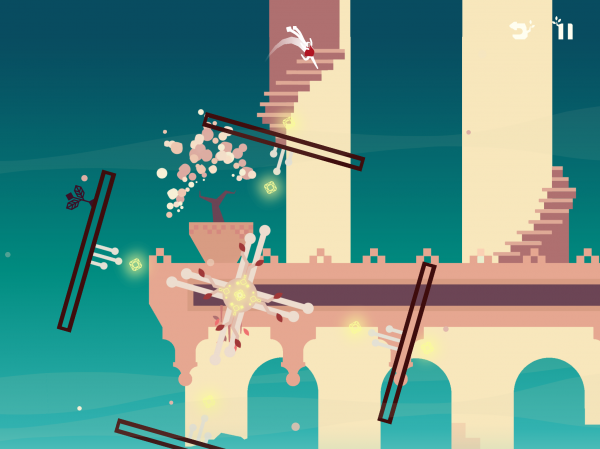Linn: Path of Orchards review
Price: $2.99
Version: 1.02
App Reviewed on: iPad Air 2
Graphics/Sound Rating:





User Interface Rating:





Gameplay Rating:





Replay Value Rating:





Overall Rating:





The things that separate great platformers from less impressive ones is all in the details. You can make a platformer beautiful, but truly great ones use its backdrops to communicate something (usually narratively and/or mechanically) meaningful to players. Likewise, platformers can be challenging, but the high watermarks of the genre always make sure that there's a fairness in its design that makes this challenge satisfying. Linn: Path of Orchards is a platformer that aims for greatness through its aesthetics and difficulty, but it falls just short of feeling like a truly standout game.

Moving monuments
Like most platformers, Linn is a level-based affair where your primary goal is to reach an exit. In this game, your goal is almost always very close to your character, but you need to find the right way to get to it. Small scale levels are nothing new for platformers (particularly ones designed for mobile), but the way you interact with them in Linn very much is.
You see, the environments in Linn are constantly moving. Platforms invert, floors tilt until they're walls, and whole levels can spin and whirl about, leaving you constantly adjusting to find footing for your character. Each level feels like an ancient machine that you're trying to escape from.
Jumping judo
When starting out in Linn, completing levels may feel like a fight. You're testing your speed and control prowess to overcome levels that seem intent on throwing you off of them. As the game gets more difficult though, fighting to get to exits as quickly as possible is less and less feasible and rewarding.
Instead, what you're supposed to do is take the movement from these levels and use it your advantage. There's an ebb and flow in each of Linn's stages, and the key to moving forward in the game effectively is to watch and respond to these patterns. When all of this is working your way, it can feel like platforms are rising up to meet your feet effortlessly. When it's not, you're jumping into walls or out into the abyss as solid ground constantly evades you.

Stutter steps
The fundamental concepts behind Linn are sound, but the things built upon its foundation are quite as sturdy. The main offender in this regard is the game's controls. Linn uses a simple swipe-based control scheme, but it's pretty difficult to dial in consistent swipes that differentiate between jumping, changing direction, or dashing. Being unable to consistently control your character naturally leads to a lot of unintended deaths in this game.
Thankfully, deaths in Linn are not particularly punishing. If you fall to your doom, levels quickly reset for you to start again without even having to hit a retry button. Dying due to control problems is not the only issue with the game though. Even when your commands feel like they’re going through as intended, Linn has some legibility issues. It’s not always clear how levels are going to move except through observation and repetition, and a lot of that has to do with the game’s aesthetic. Linn seems dead set on emulating the visual style of Monument Valley, but this minimal look also makes it hard to know what to expect from levels until you've already died on them a few times and picked up on a pattern.
The bottom line
There’s more to Linn: Path of Orchards than meets the eye, and that’s kind of the problem with it. Without having a more communicative visual design, Linn is harder to control and read accurately. This ends up making for a game that—while beautiful and creative—can be quite frustrating to actually play.




